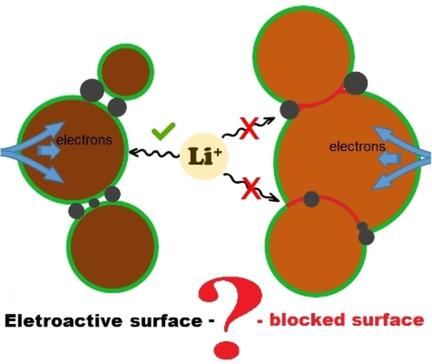当前位置:
X-MOL 学术
›
Batteries Supercaps
›
论文详情
Our official English website, www.x-mol.net, welcomes your
feedback! (Note: you will need to create a separate account there.)
A New Technique for In Situ Determination of the Active Surface Area Changes of Li–Ion Battery Electrodes
Batteries & Supercaps ( IF 5.1 ) Pub Date : 2020-05-15 , DOI: 10.1002/batt.202000088 Maciej Ratynski 1 , Bartosz Hamankiewicz 1 , Dominika A. Buchberger 1 , Maciej Boczar 1 , Michał Krajewski 1 , Andrzej Czerwinski 1
Batteries & Supercaps ( IF 5.1 ) Pub Date : 2020-05-15 , DOI: 10.1002/batt.202000088 Maciej Ratynski 1 , Bartosz Hamankiewicz 1 , Dominika A. Buchberger 1 , Maciej Boczar 1 , Michał Krajewski 1 , Andrzej Czerwinski 1
Affiliation

|
Li‐ion batteries have been of a great interest for over three decades. A geometric electrode surface area is generally used for Li‐ion electrochemical parameters calculations. Since the real electrode is a complex system composed of the thick porous structure, the contact surface area between the active mass and electrolyte is far larger than geometrical. This approximation leads to a large deviation of obtained results, especially within different laboratories and for volume and surface changing materials, e. g., silicon. The article presents a new method of in situ analysis of active surface area variations applicable for Li‐ion electrodes. The method relies on the electrochemical impedance spectroscopy measurement (EIS) performed at an arbitrarily chosen state of charge during superimposed DC current flow. The correlation between a local ion concentration with a charge transfer resistance allows to evaluate the differences of the active surface area. The presented method is not affected by the SEI layer presence, the material composition, nor the lithiation mechanism. Due to limited EIS frequency range the presented method can be performed with a relatively short time. Our new in situ surface area determination can greatly improve the accuracy of the electrochemical parameters evaluation and enable the proper result analysis. We believe that our method can become a standard procedure implemented in every research focusing on the electrochemical parameter determination of the volume changing active materials.
中文翻译:

原位测定锂离子电池电极有效表面积变化的新技术
三十多年来,锂离子电池一直备受关注。几何电极表面积通常用于锂离子电化学参数计算。由于实际电极是由厚多孔结构组成的复杂系统,因此活性物质与电解质之间的接触表面积远大于几何形状。这种近似会导致获得的结果有很大的偏差,尤其是在不同的实验室内以及对于体积和表面变化的材料(例如)。例如硅。本文介绍了一种适用于锂离子电极的有效表面积变化的原位分析新方法。该方法依赖于在叠加的直流电流流动期间以任意选择的电荷状态执行的电化学阻抗谱测量(EIS)。局部离子浓度与电荷转移电阻之间的相关性允许评估活性表面积的差异。所提出的方法不受SEI层存在,材料成分或锂化机理的影响。由于有限的EIS频率范围,所提出的方法可以在相对短的时间内执行。我们新的原位表面积测定可以大大提高电化学参数评估的准确性,并能够进行适当的结果分析。我们认为,我们的方法可以成为每项研究中实施的标准程序,专注于确定体积变化的活性材料的电化学参数。所提出的方法不受SEI层存在,材料成分或锂化机理的影响。由于有限的EIS频率范围,所提出的方法可以在相对短的时间内执行。我们新的原位表面积测定可以大大提高电化学参数评估的准确性,并能够进行适当的结果分析。我们认为,我们的方法可以成为每项研究中实施的标准程序,专注于确定体积变化的活性材料的电化学参数。所提出的方法不受SEI层存在,材料成分或锂化机理的影响。由于有限的EIS频率范围,所提出的方法可以在相对短的时间内执行。我们新的原位表面积测定可以大大提高电化学参数评估的准确性,并能够进行适当的结果分析。我们认为,我们的方法可以成为每项研究中实施的标准程序,专注于确定体积变化的活性材料的电化学参数。我们新的原位表面积测定可以大大提高电化学参数评估的准确性,并能够进行适当的结果分析。我们认为,我们的方法可以成为每项研究中实施的标准程序,专注于确定体积变化的活性材料的电化学参数。我们新的原位表面积测定可以大大提高电化学参数评估的准确性,并能够进行适当的结果分析。我们认为,我们的方法可以成为每项研究中实施的标准程序,专注于确定体积变化的活性材料的电化学参数。
更新日期:2020-05-15
中文翻译:

原位测定锂离子电池电极有效表面积变化的新技术
三十多年来,锂离子电池一直备受关注。几何电极表面积通常用于锂离子电化学参数计算。由于实际电极是由厚多孔结构组成的复杂系统,因此活性物质与电解质之间的接触表面积远大于几何形状。这种近似会导致获得的结果有很大的偏差,尤其是在不同的实验室内以及对于体积和表面变化的材料(例如)。例如硅。本文介绍了一种适用于锂离子电极的有效表面积变化的原位分析新方法。该方法依赖于在叠加的直流电流流动期间以任意选择的电荷状态执行的电化学阻抗谱测量(EIS)。局部离子浓度与电荷转移电阻之间的相关性允许评估活性表面积的差异。所提出的方法不受SEI层存在,材料成分或锂化机理的影响。由于有限的EIS频率范围,所提出的方法可以在相对短的时间内执行。我们新的原位表面积测定可以大大提高电化学参数评估的准确性,并能够进行适当的结果分析。我们认为,我们的方法可以成为每项研究中实施的标准程序,专注于确定体积变化的活性材料的电化学参数。所提出的方法不受SEI层存在,材料成分或锂化机理的影响。由于有限的EIS频率范围,所提出的方法可以在相对短的时间内执行。我们新的原位表面积测定可以大大提高电化学参数评估的准确性,并能够进行适当的结果分析。我们认为,我们的方法可以成为每项研究中实施的标准程序,专注于确定体积变化的活性材料的电化学参数。所提出的方法不受SEI层存在,材料成分或锂化机理的影响。由于有限的EIS频率范围,所提出的方法可以在相对短的时间内执行。我们新的原位表面积测定可以大大提高电化学参数评估的准确性,并能够进行适当的结果分析。我们认为,我们的方法可以成为每项研究中实施的标准程序,专注于确定体积变化的活性材料的电化学参数。我们新的原位表面积测定可以大大提高电化学参数评估的准确性,并能够进行适当的结果分析。我们认为,我们的方法可以成为每项研究中实施的标准程序,专注于确定体积变化的活性材料的电化学参数。我们新的原位表面积测定可以大大提高电化学参数评估的准确性,并能够进行适当的结果分析。我们认为,我们的方法可以成为每项研究中实施的标准程序,专注于确定体积变化的活性材料的电化学参数。











































 京公网安备 11010802027423号
京公网安备 11010802027423号